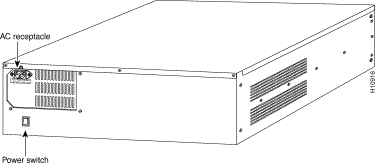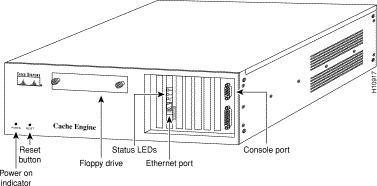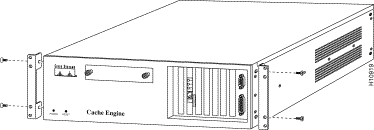|
|

After you determine where you want to put the Cache Engine, follow these steps to complete the Cache Engine installation:
Step 1 Collect the Information Required for Configuration.
Step 2 Install the Cache Engine.
Step 3 Initialize the Cache Engine Configuration.
Step 4 Enable Cache Support on the Router.
Step 5 Test the Cache Engine Installation.
Read the Regulatory Compliance and Safety Information document that came with the Cache Engine before you begin the installation.
 | Warning Read the installation instructions before you connect the system to its power source. |
Before you install the machine, collect the information required for the basic configuration:
 | Warning Do not touch the power supply when the power cord is connected. For systems with a power switch, line voltages are present within the power supply even when the power switch is off and the power cord is connected. For systems without a power switch, line voltages are present within the power supply when the power cord is connected. |
 | Warning The device is designed to work with TN power systems. |
 | Warning The ports labeled "Ethernet," "10BaseT," "Token Ring," "Console," and "AUX" are safety extra-low voltage (SELV) circuits. SELV circuits should only be connected to other SELV circuits. Because the BRI circuits are treated like telephone-network voltage, avoid connecting the SELV circuit to the telephone network voltage (TNV) circuits. |
 | Warning This product relies on the building's installation for short-circuit (overcurrent) protection. Ensure that a fuse or circuit breaker no larger than 120 VAC, 15A U.S. (240 VAC, 10A international) is used on the phase conductors (all current-carrying conductors). |
 | Warning This equipment is intended to be grounded. Ensure that the host is connected to earth ground during normal use. |
 | Warning Do not work on the system or connect or disconnect cables during periods of lightning activity. |
 | Warning Before working on equipment that is connected to power lines, remove jewelry (including rings, necklaces, and watches). Metal objects will heat up when connected to power and ground and can cause serious burns or weld the metal object to the terminals. |
Refer to Figure 2-2 and Figure 2-1 when installing the engine, to help you identify the connectors on the front and back of the engine.


To install the Cache Engine:
Step 1 Place the Cache Engine unit in the desired location. You can mount it on a rack for your convenience, or place it on a solid, stable surface. Figure 2-3 shows how to attach the mounting brackets. You will need a Phillips-head screwdriver.

Step 2 Plug in the Cache Engine.
Step 3 Plug the network connection into the Ethernet port on the Cache Engine.
Step 4 Plug the console into the Console port on the Cache Engine using the supplied serial cable. Open a window for the engine console using your terminal emulation program.
Step 5 Turn on the Cache Engine. The Cache Engine begins booting, and sends messages to the console window. Once the operating system boots, you are ready to initialize the basic configuration.
Once you have installed the Cache Engine, and booted the engine's operating system, you must initialize the basic configuration. If the engine does not have a usable basic configuration (which is the case when you initially set up the engine), it presents the current configuration to you, and asks you to modify the configuration to make the Cache Engine usable. The engine prompts you through each configuration variable; you can back up to the previous variable by typing a hyphen (-) and pressing the Enter key.
To initialize the Cache Engine's basic configuration once it has booted the operating system:
Step 1 Enter values for these parameters as you are prompted:
Step 2 If the basic configuration is acceptable, enter y. The Cache Engine indicates whether the configuration is accepted. At this point, the basic configuration is finished.
Step 3 Once you have entered an acceptable basic configuration, the Cache Engine displays the URL that you would use to connect to it with a web browser. For example, http://192.168.20.121:8001 . You must use the complete URL to connect to the machine and manage it.
Before the router can use the Cache Engine, it must know that the Cache Engine exists. This notification is done automatically by communications between the engine and the router. However, you must enable cache support in the router so that the router knows to listen for the Cache Engine.
If you later want to disable caching temporarily, you can do so by disabling cache support in the router, rather than by turning off or otherwise disabling the individual Cache Engines. (Use the no ip wccp command on the router to disable caching.)
You must already know how to configure the router to make these configuration changes. If you do not know how to configure the router, consult the Cisco IOS documentation supplied with the router. Detailed information for the commands mentioned here is in the Cisco IOS documentation.
To enable cache support on the router:
Step 1 Ensure that the router is running a release of the Cisco IOS software that includes the Web Cache Control Protocol. You must upgrade the Cisco IOS software if it does not have this support before you can continue.
Step 2 In global configuration mode, use the ip wccp command to enable cache support. For example, enter:
ip wccp
For example, to enable redirection, enter:
ip web-cache redirect
You can confirm your settings using these commands on the router:
Once you have installed and configured the Cache Engine, and enabled caching on the home router, check to ensure the Cache Engine is working properly:
Step 1 From a machine on a network that uses the home router, start a web browser and open various web pages on the Internet or your intranet. The web servers you connect to must be on a different subnet, so that the request goes through the home router. Connect to some pages more than once, to ensure that some pages you request are in the cache.
Step 2 Connect to the Cache Engine's home page, and click Status. There should be activity shown for the Cache Engine.
Step 3 Use Telnet to connect to the home router, and enter the show ip wccp web-caches command to display information about the Cache Engines. The entry for the Cache Engine should show a number greater than 0 for Packets Redirected.
If the router shows that no packets are being redirected to the Cache Engine, you need to troubleshoot your setup. See Chapter 5, "Troubleshooting the Cache Engine" for more information.
![]()
![]()
![]()
![]()
![]()
![]()
![]()
![]()
Posted: Sat Sep 28 01:12:32 PDT 2002
All contents are Copyright © 1992--2002 Cisco Systems, Inc. All rights reserved.
Important Notices and Privacy Statement.